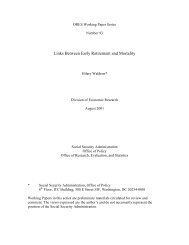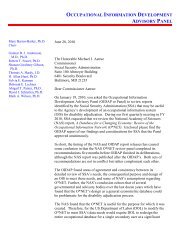shoring-up DB plans before those plans disappear orletting them slowly fade away, while focusing on waysto encourage higher participation rates and sounderinvestment choices within DC plans. In particular, ifstock market declines close to retirement age causesignificant losses in DC retirement accounts for someinvestors, policymakers may want to develop mechanismsto reduce risk in retirement assets. As moreworkers enter retirement with assets held outside ofannuities, policymakers could also develop optionsto encourage people to use their increased retirementwealth to purchase annuities instead of spending itdown rapidly. Finally, as policymakers consider proposalsto improve the solvency of the <strong>Social</strong> <strong>Security</strong>system, they must recognize that the shift from DB toDC pensions means that <strong>Social</strong> <strong>Security</strong> will increasinglybecome the only source of guaranteed lifetimebenefits of which most retirees can rely.Appendix AMINT begins with pooled SIPP data from 1990 to1996. The 1990 to 1993 panels include individualsborn from 1926 to 1965. The 1996 panel includesindividuals born from 1926 to 1972. Using a cloningprocess, MINT also creates individuals born from1973 to 2018 and immigrants that arrive after 1996.The SIPP data include numerous demographiccharacteristics, including marriage history, migrationhistory, health and disability status, and the numberand relationships of people in the household. The SIPPalso contains detailed income and wealth characteristicssuch as home equity, financial assets, pensioncharacteristics and assets, <strong>Social</strong> <strong>Security</strong> benefits andSSI payments, and income from wages and salaries,self-employment, and pensions.MINT uses earnings from <strong>Social</strong> <strong>Security</strong> administrativedata for the years 1951 through 2004 for individualswith a valid <strong>Social</strong> <strong>Security</strong> number, matchedto the 1990–1993 and 1996 SIPP panels. The modelstatistically imputes an earnings record for all nonmatchedrespondents by selecting a similar respondentwith a valid match. Matching variables in this imputationinclude age, sex, education, self-reported SIPPearnings, immigration age, and deferred contributionpension status.MINT then projects annual earnings and disabilityonset through age 67 using a “nearest neighbor”matching procedure. The model starts with a person’sown SSA-recorded earnings from 1951 to 2004. Thenearest neighbor procedure statistically assigns to each“recipient” worker the next 5 years of earnings andDI entitlement status, based on the earnings and DIstatus of a “donor” MINT observation born 5 yearsearlier with similar characteristics. The splicing of5-year blocks of earnings from donors to recipientscontinues until earnings projections reach age 67. Anumber of criteria are used to match recipients withdonors in the same age interval. These criteria includesex, minority group status, education level, DI entitlementstatus, self-employment status, average earningsover the prior 5-year period, presence of earnings inthe 4th and 5th years of the prior 5-year period, andage/sex group quintile of average prematch periodearnings. An advantage of this approach is that itpreserves the observed heterogeneity in age/earningsprofiles for earlier birth cohorts in projecting earningsof later cohorts.In a subsequent process, for all individuals whonever become DI recipients, MINT projects earnings,retirement, and benefit take-up from age 55 untildeath. These earnings replace the earnings generatedfrom the splicing method from age 55 until retirement.This postprocess allows the model to projectbehavioral changes in earnings, retirement, and benefittake-up in response to policy changes. MINT thencalculates <strong>Social</strong> <strong>Security</strong> benefits based on earningshistories and DI entitlement status of workers,marital histories, and earnings histories of current andformer spouses.<strong>Social</strong> <strong>Security</strong> benefits in MINT are calculatedusing a detailed <strong>Social</strong> <strong>Security</strong> benefit calculator.MINT’s calculated benefits use earnings from theSummary Earnings Record and should generateactual benefits from the Master Beneficiary Record.Calculated and actual benefits will not match in caseswhen the benefits are based on a former spouse. MINTselects former spouses (where earnings histories areavailable), and to ensure consistency in benefits withearnings and spouse characteristics, it uses calculated<strong>Social</strong> <strong>Security</strong> benefits. MINT’s benefits are based onfull-year values even in the first year of benefit takeup.The actuarial reduction factor accounts for the agein months at take-up, but there is no adjustment inannual benefits for part-year receipt.20 <strong>Social</strong> <strong>Security</strong> Bulletin • Vol. 69 • No. 3 • 2009
MINT projects pension coverage and benefits startingwith the self-reported pension coverage informationin the SIPP. It then links individuals to pensionplans and simulates new pension plans along with jobchanges. Pension accruals depend on the characteristicsof individuals’ specific pension plan parametersand simulated job tenure. The model also projectswealth from DC retirement accounts (that is―definedcontribution plans, individual retirement accounts, andKeogh plans) to the retirement date based on initialaccount balances and projected new contributions andinvestment earnings.This simulation model also projects housing equityand nonpension, nonhousing wealth (that is―vehicle,other real estate, and farm and business equity; stock,mutual fund, and bond values; checking, saving,money market, and certificate of deposit accountbalances―less unsecured debt). These projectionsare based on random-effects models of wealth accumulationestimated from the Panel Survey of IncomeDynamics, the Health and Retirement Study, andthe Survey of Income and Program Participation.Explanatory variables include age, recent earnings andpresent value of lifetime earnings, number of yearswith earnings above the <strong>Social</strong> <strong>Security</strong> taxable maximum,marital status, sex, number and age of children,education, race, health and disability status, pensioncoverage, self-employment status, and last year of life.In addition, MINT also projects living arrangements,SSI payments, and income of nonspouseco-residents from age 62 until death. Living arrangementsdepend on marital status, age, sex, race, ethnicity,nativity, number of children ever born, education,income and assets of the individual, and date of death.For those projected to co-reside, MINT uses a “nearestneighbor” match to assign the income and characteristicsof the other family members from a “donor” fileof co-resident families from pooled 1990 to 1993 SIPPpanels. After all incomes and assets are calculated,MINT calculates SSI eligibility and projects participationand payments for eligible participants.Finally, MINT calculates annual state and federalincome taxes from federal and state tax calculatorsand additional data from a statistical match with anenhanced Statistics of Income (SOI) file. The statisticalmatch uses a minimum distance function. The keymatch variables are filing status, age of family head,wage and salary earnings, self-employment earnings,pension income, <strong>Social</strong> <strong>Security</strong> benefits, home equity,and financial assets. The enhanced SOI is used as thedata source for interest, dividends, rental income, anditemized deductions; these variables are needed tocalculate income tax liabilities.The enhanced SOI file used with MINT is basedon the 2001 SOI file that is statistically matched to the1996 SIPP to add home equity, financial assets, andage. This match uses a minimum distance functionthat includes filing status, state, number of exemptions,wage and salary income, self-employmentincome, <strong>Social</strong> <strong>Security</strong> income, pension income,individual retirement account distributions, interest,dividends, rental income, alimony, and unemploymentcompensation.This report calculates asset income based on theannuity that families could purchase from 80 percentof financial assets. MINT uses this annuity incometo calculate retirement income; not the SOI imputedinterest, dividends, and rental income. The model usesthe potential annuity instead of capital income fromassets as an income measure to treat families with DCpensions in a manner comparable to that of familieswith DB pensions. The potential annuity amount willexceed the return on capital—interest, dividends, andrental income—because the annuity includes repaymentof principal in addition to capital income. Thisplaces the measured income from DC accounts on anequivalent scale with reported DB pension income,which includes both the return on assets and repaymentof principal.Finally, MINT projects income and demographictransitions annually from the SIPP interview yearuntil the earlier of emigration, institutionalization,death, or 2099. The earnings and benefit status comedirectly from the administrative data through 2004.Per capita income and assets depend on economic anddemographic variable (marriage, divorce, and death)changes over the period.Appendix BTable B-1 expresses the average change in mean perperson family income as a percent rather than as adollar value for winners and losers. Tables B-2 andB-3 estimate the income levels and amount of changefor winners and losers, respectively, by the level ofpercent change in income.<strong>Social</strong> <strong>Security</strong> Bulletin • Vol. 69 • No. 3 • 2009 21
- Page 1 and 2: Social SecuritySocial SecurityBulle
- Page 3: Social SecurityBulletin Vol. 69, No
- Page 6 and 7: Perspectives77 An Empirical Study o
- Page 8 and 9: Selected Abbreviations—continuedM
- Page 10: within the next few years (Aglira 2
- Page 14 and 15: coverage varies significantly by ra
- Page 16 and 17: non-Hispanic white, and college edu
- Page 18 and 19: same groups (Table 6). For the last
- Page 20 and 21: from DB to DC pensions is accelerat
- Page 22 and 23: Table 8.Percent of individuals who
- Page 24 and 25: not necessarily the largest gains a
- Page 28 and 29: Table B-1.Percent change in mean pe
- Page 30 and 31: Table B-3.Percent of individuals wh
- Page 32 and 33: ReferencesAaronson, Stephanie, and
- Page 35 and 36: Social Security Administration’s
- Page 37: Chart 1.Historical expansion of Soc
- Page 40 and 41: self-employment information for the
- Page 42 and 43: (Cronin 1985). The final earnings r
- Page 44 and 45: prior to 1950, first year of earnin
- Page 46 and 47: average indexed monthly earnings (A
- Page 48 and 49: 13For an explanation of how the sel
- Page 50 and 51: Kopczuk, Emmanuel Saez, and Jae Son
- Page 53 and 54: Occupations of SSI Recipients Who W
- Page 55 and 56: on the differences between the occu
- Page 57 and 58: prediction models. Table A-1 lists
- Page 59 and 60: Occupational Distributions of theEm
- Page 61 and 62: similar, only 4 percent of the popu
- Page 63 and 64: Table 5.Estimated occupational dist
- Page 65 and 66: Table 7.Predicted Herfindahl-Hirsch
- Page 67 and 68: Table 9.Estimated occupational dist
- Page 69 and 70: Table 11.Average annual wages of wo
- Page 71 and 72: Table A-2.Means and standard errors
- Page 73 and 74: Table A-3.Coefficients and standard
- Page 75 and 76: Table A-3.Coefficients and standard
- Page 77 and 78:
Table A-3.Coefficients and standard
- Page 79 and 80:
management, professional, and relat
- Page 81:
Stapleton, David C., Nanette Goodma
- Page 84 and 85:
Selected Abbreviations—continuedO
- Page 86 and 87:
The 1983 Amendments to the Social S
- Page 88 and 89:
Chart 1.Proportion of new claimants
- Page 90 and 91:
Table 4.The evolution of the ARF an
- Page 92 and 93:
for the test of equality of means b
- Page 94 and 95:
Table 8.Average monthly Social Secu
- Page 96 and 97:
in the chart, especially for men, t
- Page 98 and 99:
6This is a very important character
- Page 100 and 101:
Benítez-Silva, Hugo, Berna Demiral
- Page 103 and 104:
OASDI and SSI Snapshot andSSI Month
- Page 105 and 106:
Monthly Statistical Snapshot, Augus
- Page 107 and 108:
Table 2.Recipients, by eligibility
- Page 109 and 110:
SSI Federally Administered Payments
- Page 111 and 112:
Table 7.Average monthly payment, by
- Page 113:
Awards of SSI Federally Administere
- Page 116 and 117:
Copyright—Authors are responsible
- Page 119 and 120:
Program Highlights, 2009Old-Age, Su








